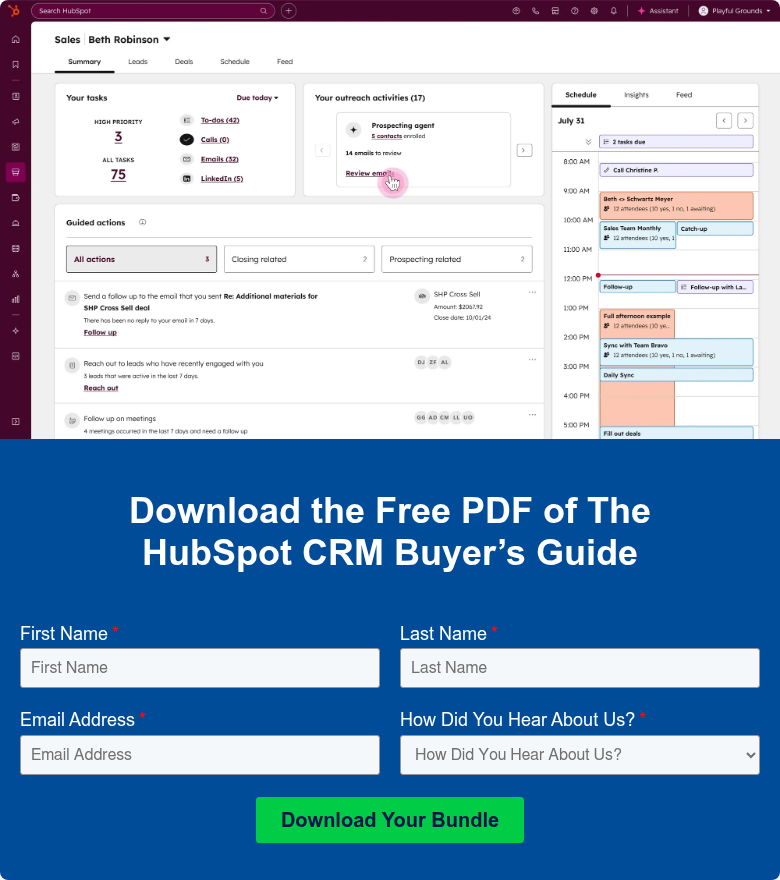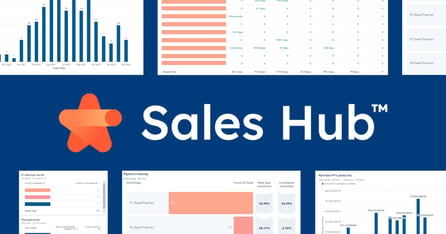Boosting B2B Sales with HubSpot Sequences: Best Practices

How do you boost your HubSpot sequences and turn a B2B prospect into a paying customer in 2022? While the process of customer acquisition has changed over time, the anticipation, thrill, and necessity of landing new business remain the same.
In today’s hyper-connected and hyper-competitive world, how do you break through the clutter to forge a relationship and make a sale?
It won’t surprise you to know that there are marketing automation providers who offer pressure-tested and verified best practices to ensure that your marketing outreach or sequences hit the right target.
Even better, you can hit your prospects at the right time with relevant messages that will get the recipient’s attention. For our money, HubSpot and HubSpot sequences features are best in class.
From CRM database management to guidance on when and how to most effectively communicate with prospects, HubSpot has “been there and done that” and has applied the findings from millions of B2B prospect interactions to create a highly sophisticated yet easy-to-use tool that scales to fit the size and scope of your prospecting ambitions.
And, if you ever get stuck, there is a library of effective learning support materials to help you get back on track.
How do you ensure a steady stream of new customers for your business year after year which, added to retained business, will add up to growth for your company and shared success for employees?
New business is the lifeblood of most companies. Find out how we use our expertise in marketing automation to help clients do business development better.
With greater return on their B2B prospecting investment with the intuitive, easy-to-master tools and resources available through automated marketing systems, like HubSpot Sequences.
Focusing on the B2B Prospect Engagement with HubSpot Sequences
Today’s B2B prospects are savvy: they understand that they are in control of the situation. The transparency that digital resources afford them — everything from pricing, to competitive comparisons, to customer satisfaction, to how a brand presents itself — is all just a click away.
Prospects are making judgments and assessments of your company (and your competitors) without you even knowing it. The act of making a good first impression may occur without your knowledge or any active engagement on your part whatsoever. That’s kind of scary.
Given this scenario, ask yourself: How do you feel about your website’s slow page speed, lack of mobile capability, unfocused blog posts written four years ago by an intern no longer with the company, or your tangled site navigation?
And more importantly, what are you going to do to remedy the situation?
If you have a vague plan to get fixes done at some point in the future, that’s not going to cut it.
Your brand is constantly being shopped — B2B customers are relentless in their search for new and more cost-effective resources — and the website is the most immediate manifestation of who you are and what you stand for. It’s being cross-referenced with your competitors, who are just as hungry for business as you are.
It’s mission-critical to provide a steady supply of engaging, relevant content that is either shared with your prospect or that they find through their search activities.
To be clear; ongoing engagement, fresh thinking, and a steady, measured cadence of shared material is vital to familiarizing your B2B target prospect with your company and its services.
Setting up the HubSpot sequences function allows you to manage and oversee all of your digital marketing communications activities. Tweak the flow of content you are sharing with prospects based on real-time feedback.
Using the dashboard function, you can find out if it’s resonating with the target audience and to what degree it is landing with them — you’ll know whether you’re getting multiple opens or just a few opens or none at all.
HubSpot sequences feature is designed to easily facilitate the sharing of case studies, video, white papers, links and more, enabling the user to truly personalize their outreach, and maximize its relevance to the target prospect.

“Always Be Helping” is the New “Always Be Closing”
Sales today is a deeply consultative and collaborative process. Being able to manage your prospects at scale is another valuable aspect of HubSpot sequences program. Even an individual user can manage literally thousands of prospects simultaneously because the system is designed to track, manage and prompt the next prospect engagement, whether it’s one week or one year from now.
Conduct research on each prospect. All businesses are dealing with stress of one kind or another, things they need help with that they can’t solve internally. Find out their pain points and concerns and position your firm as the solution that they need.
Do they have a brand new plant and need to boost sales?
Are they facing a new competitive threat or struggling in a changing regulatory environment?
Be diligent by committing to loading these key business insights into your CRM and then rely on them to guide the kind of content you should be either creating or sharing with the prospect as you make the case for your company over the competitors.
Determine what is top of mind for the target and share material, emails and video prove your company to be an indispensable part of the solution.
Provide your target customer with insights, tips and knowledge that helps them to address their challenges while demonstrating that you have the quality of insight and expertise that would make your company an indispensable partner.
However, before you crank up the CRM outbound machine, be sure to take time to understand the specific needs and nuances of your target market, their business and its challenges.
And don’t expect an immediate return on your investment, you know better than anyone what a standard B2B sales cycle looks like in your business.
Nurturing a lead and building a relationship takes more than just providing a link to a relevant news article: you’re not going to hit a seven-figure contract from it, but it is a start. (Resist the urge to just share news about your own company’s successes — it’s likely they know all about it already.)
As the saying goes, a journey of a thousand miles begins with a single step. Over time, you are building credibility and trust with each move that you make. It might take a month, several months or a year, but if you keep your prospects’ needs at the forefront, you’ll get there.
The Modern Sales Process: Art, Science, Nurturing
Sales technology has had a massive impact on how deep and wide a company can prospect. But a word of caution: While many of the resources available to sales prospecting offer automation and massive scale, the foundational element of selling is still personal. No one wants to buy anything from a robot (at least not yet).
You won’t be surprised to learn that the rise of marketing automation means that your prospects could well be getting pinged multiple times a day by vendors, spam and various and sundry business emails that they can’t even remember signing up for!
Be precise, be relevant and engaging with content (make new content a focus and have an editorial plan and strict deadlines to get the new thinking out there.
Always be providing new learning or a path to a solution to get and hold your prospects’ attention. HubSpot has guidance, best practices, and learning built into every step of the process to ensure that your HubSpot sequences activities are benefiting from the aggregated intelligence within the system.
You can’t afford not to harness the power and potential of this kind of automated marketing tool — but just be human about it.
How long is a B2B sales cycle?
Marketing automation and a more nuanced, personalized approach to prospecting will doubtlessly make the process more efficient, organized and measurable, but will it necessarily speed up sales cycle times?
Probably not.
It is rare that marketing can impact manufacturing speed, technology development or the wear out times of existing parts and materials. What marketing automation can do for a company is to allow them to reach more best fit prospects.
It facilitates more meaningful and mutually beneficial discussions with more prospects simultaneously which directly correlates to a larger and more engaged pipeline.
A B2B business pipeline filled with prospects who are going through the process of learning about your company and its solutions — all at their own pace — benefiting from your insights and market leadership, all leading to that day when a prospect becomes a client.
So what does that process look like? Today, there are a myriad of ways to engage with prospects and win them over. Better yet, marketing technology allows you to test and learn and modify your approach to increase your chances of success.
Take a look at these two examples of how to run modern, marketing automation-driven nurture outreach sequences:
Option A: Cold Call
- Prospects are researched and entered in the company’s CRM system.
- Each prospect has been researched and pain points/business challenges identified – two different target personas are identified.
- In HubSpot, information is collated and stored in the contact record, open and available to everyone on your team that might need access to the information. The system also uses an internal notes system where you can @ message your colleagues to keep up with new and relevant changes to the file. It helps keep all the meeting notes, call transcripts, and other communications on a high-value B2B customer tightly organized, and in one place.
- Outbound email sequences are set up to align with each of the two specific targets needs. HubSpot guidelines help create messages that are short, precise and to the point — sing your song and then get off stage. Chances are the target is dealing with 200+ emails a day — so you need to be concise, to the point, and addressing a real need.
- Your website is upgraded: the first thing many of these new prospects do is to come to your site to check you out.
- Attachments to these emails include articles your team has written, recent webinars you’ve conducted, and industry news that will be of value to the prospect. Gee, these guys seem to really know their stuff is the kind of response you’re looking to elicit. HubSpot stores this via an easy to manage # system that allows the relevant material to located and integrated with the click of a button
- You encourage the prospect to connect by phone with you or set up an introductory meeting call.
- Your CRM dashboard — which can be modified to prioritize and track data of the most value to your organization, versus a one-size-fits-all, cookie-cutter solution — quickly tells you whether you’re track or need to modify your approach to drive higher email open, attachment click rates and content engagement. This is a system of continuous improvement, and the CRM system feedback you receive tells you where to make upgrades or modifications.
- Based on the level of interest shown by your B2B prospects, as measured by the number of opens of the material you have sent them, you either call them or use video technology to simply say hello or to introduce a new piece of content that you think has particular value.
- An introductory meeting allows you to confirm and identify additional pain points, better understand the prospect’s business challenges and to start thinking about how to be a viable solution for this prospect.
- The prospect is signed up for your quarterly email and you continue to share articles and industry news of interest.
- Based on the B2B business category this process can run from weeks to months. Be patient, and keep your eye on the prize.
Option B: Trade Show Follow-Up
- You meet this prospect at an industry trade show. An initial conversation takes place and business cards are exchanged.
- Company and contact are entered into your HubSpot CRM, which allows you to scan card information via a photo right on the trade show floor.
- Additional research is done on the company and entered into the company record file.
- Outreach is not automated, but the CRM assists in keeping track of outbound emails, meetings and calls, the content that will be shared with the prospect, and the timing and length of the nurture sequence – HubSpot Sequences offer options of how long you wait between prospect engagements so that the prospect don’t feel bombarded.
- Because the content you plan to share has been shared with other prospects, you may elect to use templated emails, which are easily set up and managed through HubSpot, in order to standardize your approach and minimize the time spent on outreach.
- The CRM tracks what has been shared with the prospect and the timing of relevant upcoming material, which will continue to position your firm as a valuable resource to the B2B prospect.
- You determine when the prospect might likely be ready to become a client and work your efforts back from that date.
HubSpot Sequences and Sales Automation: Casting a Wider Net
Success in business has always been predicated on the ability to grow or, in more modern terms, to ‘scale up’. This is so vitally important to those in the B2B selling space, whose sales cycles can run months if not years.
The tools and engagement best practices that are built into systems like HubSpot mean that any company, no matter its size, has the opportunity to win in a competitive marketplace.
Companies committed to understanding the needs of its customers and prospects have the ability to create pulsed and sequenced content that engages and educates their target audience.
That means they can cast a much wider net to capture more best fit prospects. The end result is more prospects looking at your company and its offering in a new and fully engaged way.
The features of the system enable a small, B2B-focused business development team to break free from geographic constraints, tedious spreadsheets, and time boxed sales cycles in order to talk to more future customers, more effectively, over longer sales cycles.
The HubSpot sequences system is designed to work for you versus your working for it. That’s welcome news for all who currently struggle to use cobbled-together business development systems.
Get in touch and let’s talk about how to get you started.




